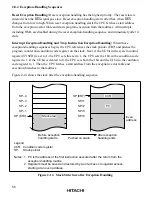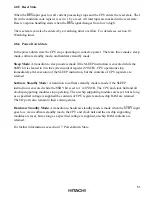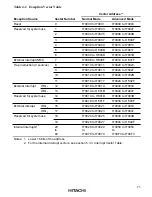
55
Section 3 MCU Operating Modes
3.1 Overview
3.1.1 Operating Mode Selection
The H8/3022 Series has five operating modes (modes 1, 3, 5 to7) that are selected by the mode
pins (MD
2
and MD
0
) as indicated in table 3-1. The input at these pins determines expanded mode
or single-chip mode.
Table 3-1 Operating Mode Selection
Mode Pins
Description
Operating
Mode
MD
2
MD
1
MD
0
Address Space
Initial Bus
Mode
*
1
On-Chip
ROM
On-Chip
RAM
—
0
0
0
—
—
—
—
Mode 1
0
0
1
Expanded mode
8 bits
Disabled
Enabled
*
1
Mode 2
0
1
0
—
—
—
—
Mode 3
0
1
1
Expanded mode
8 bits
Disabled
Enabled
*
1
Mode 4
1
0
0
—
—
—
—
Mode 5
1
0
1
Expanded mode
8 bits
Enabled
Enabled
*
1
Mode 6
1
1
0
Expanded mode
8 bits
Enabled
Enabled
*
1
Mode 7
1
1
1
Single-chip advanced mode
—
Enabled
Enabled
*
2
Notes: 1. If the RAM enable bit (RAME) in the system control register (SYSCR) is cleared to 0,
these addresses become external addresses.
2. In mode 7, clearing bit RAME in SYSCR to 0 and reading the on-chip RAM always
return H’FF, and write access is ignored. For details, see section 14.3, Operation.
For the address space size there are two choices: 1 Mbyte, or 16 Mbytes.
Modes 1 and 3 are on-chip ROM disable expanded modes capable of accessing external memory
and peripheral devices.
Mode 1 supports a maximum address space of 1 Mbyte. Mode 3 supports a maximum address
space of 16 Mbytes.
Modes 5 and 6 are externally expanded mode that enables access to external memory and
peripheral devices and also enables access to the on-chip ROM. Mode 5 supports a maximum
address space of 1 Mbyte.
Mode 6 supports a maximum address space of 16 Mbyte.
















































